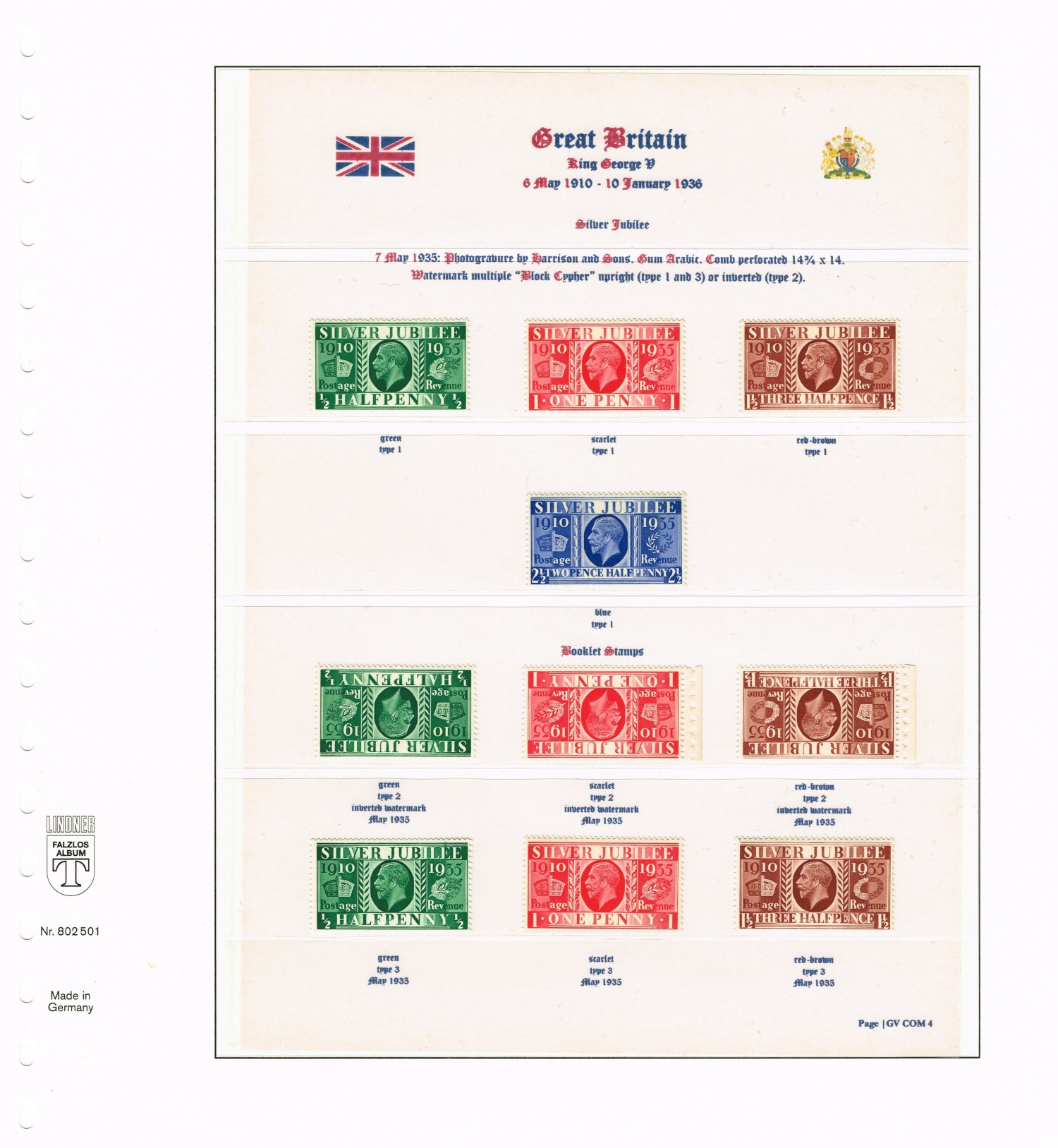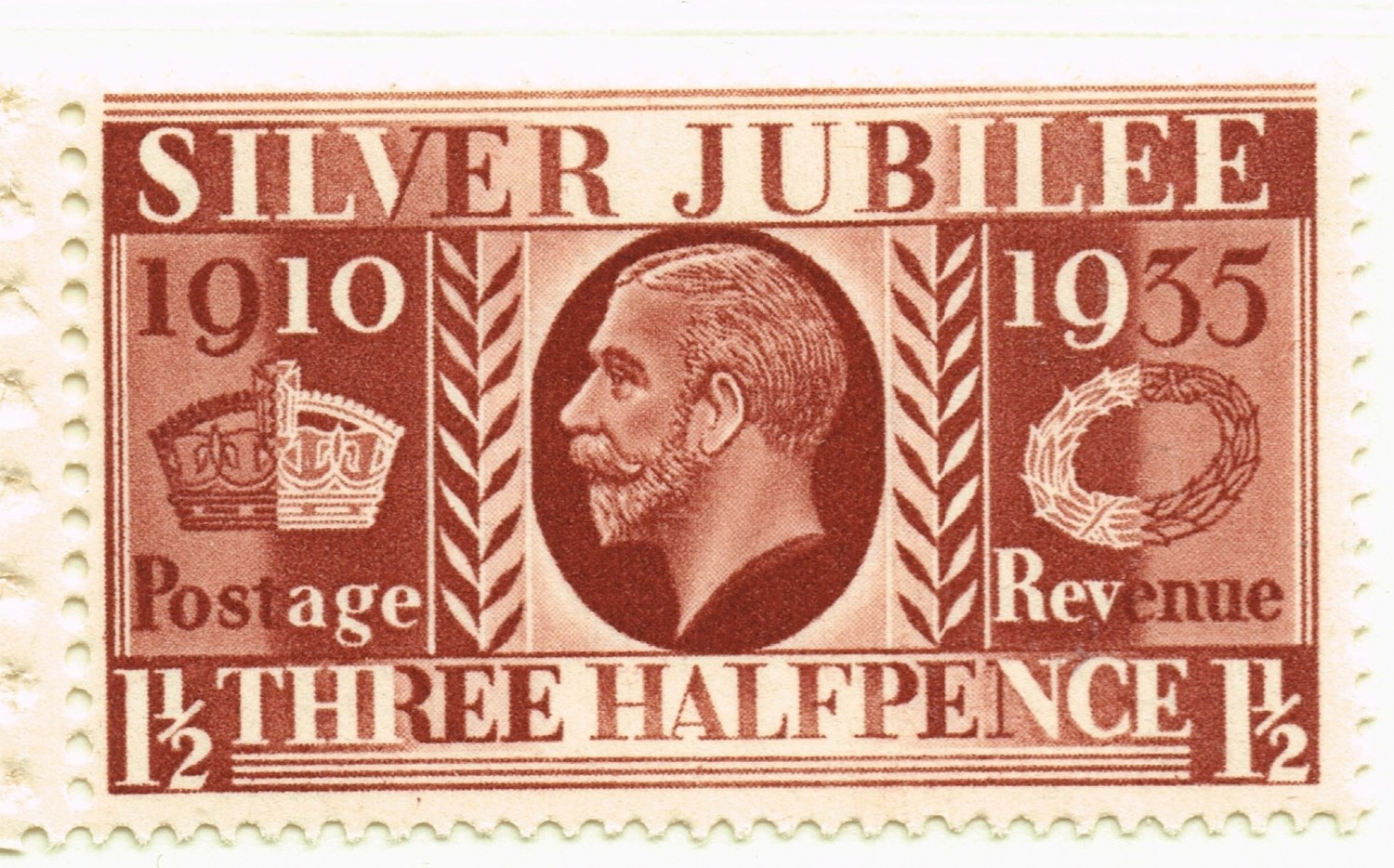Post by Deleted on Apr 12, 2020 9:18:43 GMT -5
Silver Jubilee (1935)
George V acceded to the throne on 6 May 1910. On 7 May 1935, the General Post Office issued a set of four stamps to celebrate the 25th anniversary (silver jubilee) of his accession.
A printing of the 2½d stamp was made in a turquoise blue shade, known to collectors as Prussian blue. Four sheets were issued in error by the Post Office Stores Department in error. Three of the four sheets were sold from the sub-office at 134 Fore Street, Upper Edmonton, London between 24 June and 5 July.
During this time, Mr. A.J. Stavridi had sent his secretary to the post office to buy stamps. When she returned, he noticed the strange colour and went to the post office. Of the 360 stamps, 41 had been sold. He bought the remaining stamps and used a few to send to fellow collectors.
In May 1935, stamp books containing the three lower values of the jubilee issues were also issued. These were printed from separate cylinders and exist with upright and inverted watermarks as usual for booklet stamps. The booklet stamps can be distinguished from sheet stamps. Sheet stamps have been assigned type 1. Booklet stamps have been assigned types 2 and 3. These coincide with the inverted and upright watermarks, respectively.

1935, King George V Silver Jubilee, SG 453 – 456 (type 1) and booklet stamps types 2 and 3.
HALFPENNY
The “FPE” of halfpenny are solid on the sheet (type 1) stamps. The bottom half of these letters are lightly shaded on the booklet stamps. The Stanley Gibbons Great Britain Specialised catalogue mentions the lines below the word halfpenny are thicker on the type 2 than on the type 3 stamp. I do not find this is very clear. I find the shading around the “fleur-de-lis” in the right half of the crown is better defined and deeper on the type 3 stamp than on the other types. Also, the line at the top of the medallion with the King’s head is weaker on the type 2 stamp. In the other stamps, the medallion touches this line. On the type 1 stamp the line and medallion even seem to overlap.

SG 453, type 1 (sheets)

SG 453wi, type 2, inverted watermark (booklet)

SG 453, type 3 (booklet)
ONE PENNY
The shading between “NN” of penny on the booklet stamp with inverted watermark (type 2) is narrow. On the other two types, this is much wider and comes closer to the left-hand N. The shading of the “fleur-de-lis” on the right side of the crown and its surrounding are much deeper on the type 3 (booklet) stamp than on the type 1 (sheet) stamp.

SG 454, type 1 (sheets)

SG 454wi, type 2, inverted watermark (booklet)

SG 455, type 3 (booklet)
THREE HALFPENCE
The top frame lines are thicker and deeper on the sheet (type 1) stamp. The type 3 stamp has a thickening in the topmost line over “JU” of jubilee that the type 2 stamp does not have.

SG 455, type 1 (sheets)

SG 455wi, type 2, inverted watermark (booklet)

SG 455, type 3 (booklet)
George V acceded to the throne on 6 May 1910. On 7 May 1935, the General Post Office issued a set of four stamps to celebrate the 25th anniversary (silver jubilee) of his accession.
A printing of the 2½d stamp was made in a turquoise blue shade, known to collectors as Prussian blue. Four sheets were issued in error by the Post Office Stores Department in error. Three of the four sheets were sold from the sub-office at 134 Fore Street, Upper Edmonton, London between 24 June and 5 July.
During this time, Mr. A.J. Stavridi had sent his secretary to the post office to buy stamps. When she returned, he noticed the strange colour and went to the post office. Of the 360 stamps, 41 had been sold. He bought the remaining stamps and used a few to send to fellow collectors.
In May 1935, stamp books containing the three lower values of the jubilee issues were also issued. These were printed from separate cylinders and exist with upright and inverted watermarks as usual for booklet stamps. The booklet stamps can be distinguished from sheet stamps. Sheet stamps have been assigned type 1. Booklet stamps have been assigned types 2 and 3. These coincide with the inverted and upright watermarks, respectively.

1935, King George V Silver Jubilee, SG 453 – 456 (type 1) and booklet stamps types 2 and 3.
HALFPENNY
The “FPE” of halfpenny are solid on the sheet (type 1) stamps. The bottom half of these letters are lightly shaded on the booklet stamps. The Stanley Gibbons Great Britain Specialised catalogue mentions the lines below the word halfpenny are thicker on the type 2 than on the type 3 stamp. I do not find this is very clear. I find the shading around the “fleur-de-lis” in the right half of the crown is better defined and deeper on the type 3 stamp than on the other types. Also, the line at the top of the medallion with the King’s head is weaker on the type 2 stamp. In the other stamps, the medallion touches this line. On the type 1 stamp the line and medallion even seem to overlap.

SG 453, type 1 (sheets)

SG 453wi, type 2, inverted watermark (booklet)

SG 453, type 3 (booklet)
ONE PENNY
The shading between “NN” of penny on the booklet stamp with inverted watermark (type 2) is narrow. On the other two types, this is much wider and comes closer to the left-hand N. The shading of the “fleur-de-lis” on the right side of the crown and its surrounding are much deeper on the type 3 (booklet) stamp than on the type 1 (sheet) stamp.

SG 454, type 1 (sheets)

SG 454wi, type 2, inverted watermark (booklet)

SG 455, type 3 (booklet)
THREE HALFPENCE
The top frame lines are thicker and deeper on the sheet (type 1) stamp. The type 3 stamp has a thickening in the topmost line over “JU” of jubilee that the type 2 stamp does not have.

SG 455, type 1 (sheets)

SG 455wi, type 2, inverted watermark (booklet)

SG 455, type 3 (booklet)









